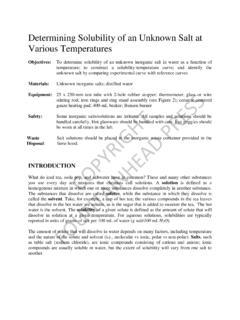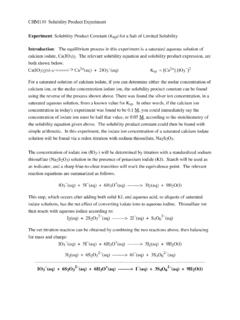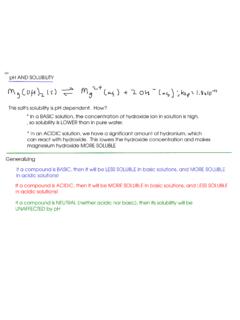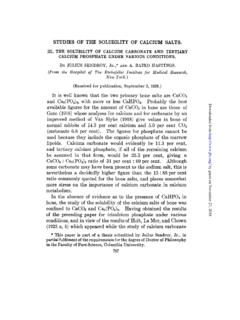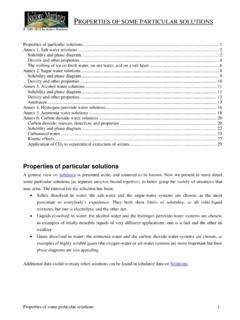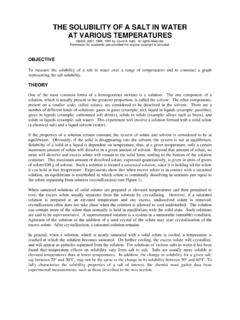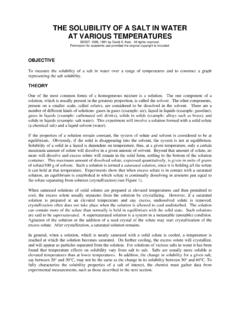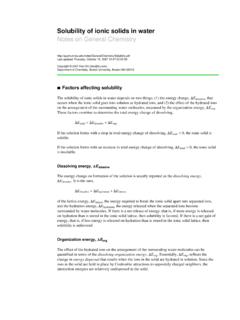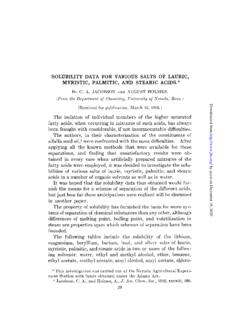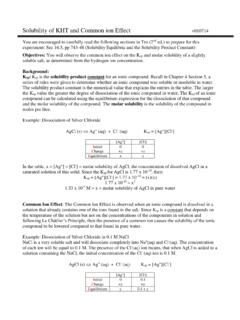Transcription of LAB: HOW CAN MINERALS FORM FROM WATER? Name
1 LAB: HOW CAN MINERALS form FROM water ? name : Many MINERALS form from the cooling of magma, but MINERALS can also form from other processes. Hydrothermal MINERALS are formed by concentration of hot, aqueous solutions flowing through cracks and pore spaces in crustal rocks. Sedimentary MINERALS are formed by evaporation of lake or seawater. Purpose: The purpose of this lab is to investigate the solubility of MINERALS in water and the effects of temperature on solubility . Each group will choose a temperature (between 0-100 0C) that they will dissolve salt crystals into 50 mL of water to the point of saturation.
2 As a class we will construct a solubility curve for the water softener salt crystals. We will also observe MINERALS forming as a result of evaporation (cooling). Class Materials: 250 mL beakers Tap water 100 mL graduated cylinder Hot plate Weighing boat (or paper) Stirring rod salt Thermometer Ice water Access to a balance Graph paper Procedure: Part I 1. Use the graduated cylinder to add 100 mL of tap water to a 250 mL beaker. 2. Place a weighing boat (or piece of paper) on the balance and record its mass. 3. Add about 75 g of salt to the weighing boat. It does not have to be exactly 75 g, but you should record the mass of the weighing boat and salt to the nearest tenth of a gram.
3 4. Slowly add about 5 g of the salt from the weighing boat to the beaker containing the 100 mL of tap water . Stir until all the salt is dissolved before adding any more salt . 5. Continue to gradually add salt to the water until no more will dissolve after you have stirred the solution for two minutes. The solution is now saturated. 6. Use a thermometer to record the final temperature of the saturated solution and record in the data table below. 7. Mass the weighing boat and the remaining salt and record. Part II 1. Use the graduated cylinder to add 100 mL of ice water to a 250 mL beaker. Try to get a few pieces of ice into the 100 mL of ice water .
4 2. Subtract the mass of the weighing boat from the final mass of the weighing boat and salt from part 1 of this experiment. Add enough salt to weighing boat containing the salt from part 1 to bring the mass of salt back up to about 75 g. Record this mass to the nearest tenth of a gram. 3. Slowly add about 5 g of the salt from the weighing boat to the beaker containing the 100 mL of ice water . Stir until all the salt is dissolved before adding anymore salt . 4. Continue to gradually add salt to the water until no more will dissolve after you have stirred the solution for two minutes. The solution is now saturated.
5 5. Use a thermometer to record the final temperature of the saturated solution and record in the data table below. 6. Mass the weighing boat and the remaining salt and record. Part III 1. Use the graduated cylinder to add 100 mL of water to a 250 mL beaker. Place the beaker with the 100 mL of water on a hot plate and heat it until it is about 90 C. Turn off the hot plate, but do not remove the beaker. Your teacher may actually provide the hot water for you. 2. Subtract the mass of the weighing boat from the final mass of the weighing boat and salt from part 2 of this experiment. Add enough salt to weighing boat containing the salt from part 2 to bring the mass of salt back up to about 75 g.
6 Record this mass to the nearest tenth of a gram. 3. Slowly add about 5 g of the salt from the weighing boat to the beaker containing the 100 mL of hot water . Stir until all the salt is dissolved before adding anymore salt . 4. Continue to gradually add salt to the water until no more will dissolve after you have stirred the solution for two minutes. The solution is now saturated. 5. Use a thermometer to record the final temperature of the saturated solution and record in the data table below. 6. Mass the weighing boat and the remaining salt and record 7. Pour the water from your beaker into a petri dish and set aside.
7 Observe what happens over the week as the water cools and evaporates. Data Sheet Hypothesis: In this experiment you are going to determine the amount of salt that will dissolve in cold water , water from the tap, and hot water . Formulate a hypothesis of what you think will happen in this experiment. Data: Mass of Weighing Boat (g) Initial Mass of Weighing Boat and salt (g) Final Mass of Weighing Boat and salt (g) Final Temperature (oC) Tap water Cold water Hot water Calculations: 1. Subtract the final mass of the weighing boat and salt from the initial mass of the weighing boat and salt for the tap water and record in the table below.
8 This is the amount of salt that dissolved in the tap water . 2. Repeat step 1 for the cold water trial and the hot water trial and record in the table below. Mass of salt in Solution (g) Tap water Cold water Hot water Graph: Graph the final temperature of the solution vs. the mass of salt in solution. Put temperature on the X-axis and the mass of salt in solution on the Y-axis. Analysis: (Please answer in complete sentences): 1. How do your results compare to your hypothesis? Was your hypothesis correct? 2. How does temperature affect the solubility of a substance? 3. In the experiment, what was the solvent and what was the solute?
9 4. From your graph, how much salt would dissolve at 50 C? 5. From your graph, what temperature of water is required to dissolve 25 g of salt ? 6. What do you think will happen to your saturated solution from part III as it cools? 7. Given what you learned about solubility and temperature, why do you think hydrothermal MINERALS require a source of very hot water ? Explain.

